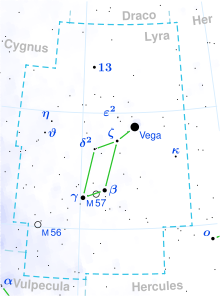Top Qs
Timeline
Chat
Perspective
Zeta1 Lyrae
Star in the constellation Lyra From Wikipedia, the free encyclopedia
Remove ads
Zeta1 Lyrae, Latinized from ζ1 Lyrae, is a binary star in the northern constellation of Lyra. Based upon an annual parallax shift of 20.89 mas as seen from Earth,[1] the pair are located about 156 light years from the Sun. It is visible to the naked eye with an apparent visual magnitude of 4.37.[2]
Remove ads
Observational history

ζ1 Lyrae was discovered to be a spectroscopic binary by William Wallace Campbell and Heber Doust Curtis in 1905 from photographic plates taken at the Lick Observatory between 1902 and 1904.[12] The first orbit was calculated by Frank Craig Jordan of Allegheny Observatory in 1910 with results in good agreement with the most recent orbit.[13]
Several other faint stars within about an arc-minute have been listed as companions, but none are physically associated with ζ1 Lyrae.[14]
Remove ads
Binary system
This is a single-lined spectroscopic binary system with an orbital period of 4.3 days and a nearly circular orbit with an eccentricity of 0.01.[5] The primary, component A, is an Am star with a stellar classification of kA5hF0mF2. This complex notation indicates that the spectral type determined solely from the calcium K line would be A5, the spectral type determined from other metallic lines would be F2, and the type determined from hydrogen lines would be F0.[3]
Remove ads
Variability
ζ1 Lyrae appears to be slightly variable, with a frequency of 0.65256 cycles per day and an amplitude of 0.0032 in magnitude.[15] The star has an estimated 2.36[6] times the mass of the Sun and around 2.5[7] times the Sun's radius. The position of this system is associated with an X-ray source with a luminosity of 571.6×1020 W.[16]
References
Wikiwand - on
Seamless Wikipedia browsing. On steroids.
Remove ads

